Health Monitoring and Evaluation of Long-Span Bridges Based on Sensing and Data Analysis: A Survey
Abstract
:1. Introduction
- (1)
- The sensor system is aimed at obtaining load, environment, and structural response information.
- (2)
- The data acquisition and transmission system is aimed at signal acquisition, caching, and transmission.
- (3)
- The data processing and control system is aimed at routine data processing and analysis, system status monitoring, remote control, and structural warning.
- (4)
- The evaluation system is aimed at executing the original monitoring data analysis, structural status evaluation, diagnosis, and prediction.
- (5)
- The data management system is aimed at storage and extraction of the monitoring data and analysis results.
- (6)
- The inspection and maintenance system is aimed at sensors for inspection and maintenance, data acquisition unit, data transmission network and display equipment, etc.
2. Health Monitoring Contents
3. Sensing Technology
3.1. Sensor
3.2. Optimum Layout of the Sensors
4. Sensing Information
4.1. Data Acquisition
- (1)
- If the measuring points are relatively far apart and scattered, the distributed acquisition mode should be adopted.
- (2)
- If the measuring points are relatively close to each other and concentrated, the centralized acquisition mode or that combined with the distributed mode should be adopted.
4.2. Data Transmission
- (1)
- If the monitoring range is small, it shall be based on the signal synchronization technology.
- (2)
- If the monitoring range is large, it shall be based on the time synchronization technology [25].
- (3)
- If the electromagnetic interference cannot be shielded in bridge monitoring, cable transmission shall be adopted.
- (4)
- If it is in surroundings where the layout and the maintenance of wires are difficult, or if it is necessary to build the monitoring structure which can temporarily transmit network data, wireless transmission [26] shall be adopted.
- (5)
- According to the needs of the projects, one or more modes can be combined.
4.3. Data Processing
4.4. Data Management
- (1)
- The static database includes information on design and construction, daily management and maintenance, system software, and hardware.
- (2)
- The dynamic database includes information on monitoring, analysis results, and maintenance recommendations.
5. Bridge Safety Evaluation Based on Sensing Information
6. Application Analysis
6.1. Engineering Outline
6.2. Layout and Installation of Measuring Points and Sensors
- (1)
- On the main girder. Along the longitudinal direction of the bridge, the vibrating wire strain sensors were attached to the lower edge of the top slab and the upper edge of the bottom slab, which are shown in Figure 4. It is worth mentioned that the sensor could also measure the temperature of the structure and modify the initial temperature [33]. In addition, the correlation function [34] of the stress-time relation curve could be established by monitoring the corresponding embedded sensors in the construction process. The purpose was to obtain stress monitoring of the bridge structure under the dead load and the live load. Also, static level gauges based on the pipe principle = were installed to monitor the static long-term deformation of the girder. Meanwhile, the GNSS (Global Navigation Satellite System) was installed to monitor the spatial mid-span deformation. Also, the displacement sensors and the acceleration sensors were installed to measure the width of the expansion joint and to test the dynamic characteristics, respectively.
- (2)
- On the cables. Before the cable tension in the construction stage and anchorage of the cable and tower, intelligent anchor cable meters with temperature measuring functions were embedded to monitor the cable force. To accurately measure the cable force under the eccentric load, the intelligent six-string type meters should be adopted.
- (3)
- On the main tower. The tiltmeters and GNSS were installed on the top of the tower. Also, a monitoring station aimed at meteorological factors was set up. The monitoring contents included the wind speed, wind direction, rainfall, and humidity.
6.3. Safety Evaluation System Based on Envelope Theory
6.4. Monitoring and Evaluation
- (1)
- Displacement: via the baseline calculation software (spider) and analysis software (GeoMoS), the spatial deformation information of the mid-span collected by GNSS could be changed into the longitudinal, transverse, and vertical deformation with respect to the reference time. After the correction of the temperature factor, the monitoring information would enter the evaluation system, and the results are shown in Figure 9, Figure 10 and Figure 11.
- (2)
- Stress: the strain information would be collected by the vibrating wire strain sensor (including the function of temperature). Then, according to the constitutive relationship between stress and strain, the stress of the structure would be calculated under the loads. Via the evaluation system, the evaluation results of the top slab and bottom slab stress along the longitudinal direction in the mid-span are shown in Figure 12 and Figure 13.
- (3)
- Cable force: the measured information from the embedded and intelligent anchor cable meter would be corrected by the temperature, and the real cable force would be obtained. Then via the evaluation system, the monitoring and evaluation results of the longest cable are shown in Figure 14.
- (4)
- Dynamic characteristics: when the temperature was stable and no train was passing, the acceleration signal was sampled. Then, the signal was transformed by FFT (Fast Fourier Transform), and the natural frequency of vibration was obtained. The monitoring result is shown in Figure 15.
- (1)
- Based on Figure 9, which was aimed at longitudinal deformation in the mid-span section, the measured extreme was −5 mm which meant the bridge was deviating to the river bank, and it was located in the normal state envelope interval [−17 mm, 17 mm]. The theoretical extreme was −17 mm, so was less than 1, which indicated that the longitudinal stiffness was normal.
- (2)
- Based on Figure 10 which was aimed at the transverse deformation in the mid-span section, the measured extreme was 4 mm which meant the bridge was deviating from upstream to downstream, and it was located in the normal state envelope interval [−63 mm, 63 mm]. The theoretical extreme was 63 mm, so was less than 1, which indicated that the transverse stiffness was normal.
- (3)
- Based on Figure 11 which was aimed at the vertical deformation in the mid-span section, the measured extreme was −24 mm which meant the bridge was deviating from upstream to downstream, and it was located in the normal state envelope interval [−166 mm, 77 mm]. The theoretical extreme was −166 mm, so was less than 1, which indicated that the vertical stiffness was normal.
- (4)
- Based on Figure 12 which was aimed at the top slab stress (point 2) in the mid-span section, the measured extreme was −2.56 MPa which indicated compressive stress, and it was located in the normal state envelope interval [−2.79 MPa, −0.78 MPa]. The theoretical extreme was −2.79 MPa, so was less than 1, which indicated that the stiffness of the top slab was normal.
- (5)
- Based on Figure 13 which was aimed at the bottom slab stress (point 5) in the mid-span section, the measured extreme was −0.87 MPa which indicated compressive stress, and it was located in the normal state envelope interval [−1.43 MPa, 1.35 MPa]. The theoretical extreme was −1.43 MPa, so was less than 1, which indicated that the stiffness of the bottom slab was normal.
- (6)
- Based on Figure 14 which was aimed at the cable force of the longest cable, the measured extreme was 2953.6 kN and it was located in the normal state envelope interval [2843.9 kN, 3107.3 kN]. The theoretical extreme was 3107.3 kN, so was less than 1, which indicated that the cable force was normal.
7. Conclusions
- (1)
- The rapid development of sensor technology has provided strong technical support for the health monitoring and evaluation of long-span bridges. It is urgent to adopt new theories and new effects so as to study and develop bridge monitoring sensing devices which are reliable, stable, and durable.
- (2)
- The health monitoring and evaluation projects of long-span bridges have been spawned by many committed companies. They are immersed in this smooth and prosperous situation. Moreover, the monitoring system including the sensors and the collection, transmission, processing, and management of sensing information, also has its own unique characteristics, advantages, and disadvantages, which are difficult to evaluate effectively. So following the maximization principle of the “cost-benefit ratio”, the optimization of the design can be carried out, and the monitoring standardization system can be established to realize standardization.
- (3)
- The analysis of the engineering application demonstrates that the comprehensive evaluation can be effectively combined with individual control indicators. Also, the objective evaluation of the bridge state can be conducted. However, for long-span bridges, using new ideas and concepts to achieve practical safety evaluation techniques based on massive sensor information are still great challenges for engineers to overcome, including conducting structural damage prognosis and safety prognosis studies [40].
Acknowledgments
Author Contributions
Conflicts of Interest
References
- Li, H.; Zhou, W.S.; Ou, J.P.; Yang, Y. A study on system integration technique of intelligent monitoring systems for soundness of long-span bridges. China Civ. Eng. J. 2006, 39, 46–52. [Google Scholar] [CrossRef]
- Li, Z.M.; Li, J.X.; Chen, R.Z. Research of Bridge Structural Health Monitoring Data Acquisition System Design Method. Sci. Technol. Eng. 2008, 8, 3633–3636. [Google Scholar]
- Chen, B.; Wang, X.; Sun, D.; Xie, X. An integrated system for structural health monitoring and intelligent management for a cable-stayed bridge. Sci. World J. 2014, 2014, 689471. [Google Scholar] [CrossRef] [PubMed]
- Hui, L.I.; Ou, J. Structural health monitoring: From sensing technology stepping to health diagnosis. Procedia Eng. 2011, 14, 753–760. [Google Scholar] [CrossRef]
- Ko, J.M.; Ni, Y.Q. Technology developments in structural health monitoring of large-scale bridges. Eng. Struct. 2005, 27, 1715–1725. [Google Scholar] [CrossRef]
- Kashima, S.; Yanaka, Y.; Suzuki, S. Monitoring the Akashi Kaikyo Bridge: First Experiences. Struct. Eng. Int. 2001, 11, 120–123. [Google Scholar] [CrossRef]
- Zhao, X.; Liu, H.; Yu, Y.; Xu, X.; Hu, W.; Li, M.; Ou, J. Bridge displacement monitoring method based on laser projection-sensing technology. Sensors 2015, 15, 8444–8463. [Google Scholar] [CrossRef] [PubMed]
- Ma, H.W.; Nie, Z.H. Research progress and reflection on safety monitoring of bridges. Mech. Eng. 2015, 37, 161–170. [Google Scholar]
- Zhang, X. Health monitoring of bridge structure. Traffic World. 2014, 3, 112–114. [Google Scholar]
- Li, H.; Ren, L.; Jia, Z.; Yi, T. State-of-the-art in structural health monitoring of large and complex civil infrastructures. J. Civ. Struct. Health Monit. 2016, 6, 3–16. [Google Scholar] [CrossRef]
- Li, P.F.; Wu, T.C. Review of bridge health monitoring technology. Prestress. Technol. 2011, 84, 29–33. [Google Scholar]
- Mufti, A. Guidelines for Structural Health Monitoring; ISIS Canada: Winnipeg, MB, Canada, 2001. [Google Scholar]
- Aktan, A.E.; Catbas, F.N.; Grimmelsman, K.A. Development of a Model Health Monitoring Guide for Major Bridges; CONIRACT/ORDER NO DTFH61-01-P-00347 2002; Federal Highway Administration Research and Developmen: Washington, DC, USA, 2012. [Google Scholar]
- Rucker, W.; Hille, F.; Rohrmann, R. Guideline for Structural Health Monitoring; SAMCO F08b; Federal Institute of Materials Research and Testing (BAM): Berlin, Germany, 2006. [Google Scholar]
- Ministry of Transport of the People’s Republic of China. Technical Specification for Structural Safety Monitoring Systems of Highway Bridges (JT/T 1037-2016); China Communication Press: Beijing, China, 2016.
- Li, J.; Deng, J.; Xie, W. Damage Detection with Streamlined Structural Health Monitoring Data. Sensors 2015, 15, 8832–8851. [Google Scholar] [CrossRef] [PubMed]
- Sun, X.Y. Research Progress on health monitoring technology of bridge structure. J. China Foreign Highw. 2006, 26, 141–146. [Google Scholar]
- Wang, H.; Tao, T.Y.; Li, A.Q. Structural health monitoring systems for Sutong Cable-stayed Bridge. Smart Struct. Syst. 2016, 18, 317–334. [Google Scholar] [CrossRef]
- Li, J.; Hao, H.; Fan, K.Q. Development and application of a relative displacement sensor for structural health monitoring of composite bridges. Struct. Control Health Monit. 2014, 22, 726–742. [Google Scholar] [CrossRef] [Green Version]
- Lu, Z.Z.; Zhou, J.T.; Chen, Y. Dynamic Stress Monitoring Sensor of Multi-direction Concrete. Chinese Patent CN204269262U, 15 April 2015. [Google Scholar]
- Guyan, R.J. Reduction of stiffness and mass matrices. AIAA J. 1995, 3, 380. [Google Scholar] [CrossRef]
- Breitfeld, T. A method for identification of a set of optimal measurement points for experimental modal analysis: Modal analysis. Int. J. Anal. Exp. Modal Anal. 1996, 11, 254–273. [Google Scholar]
- Johnson, G.W.; Jennings, R. LabVIEW Graphics Programming; Peking University Press: Beijing, China, 2002. [Google Scholar]
- National Instruments Corporation. Labwindows/CVI Basics I; National Instruments: Austin, TX, USA, 1998. [Google Scholar]
- Araujo, A.; Garcia-Palacios, J.; Blesa, J. Wireless Measurement System for Structural Health Monitoring With High Time-Synchronization Accuracy. IEEE Trans. Instrum. Meas. 2012, 61, 801–810. [Google Scholar] [CrossRef] [Green Version]
- Whelan, M.J.; Gangone, M.V.; Janoyan, K.D. Highway Bridge Assessment Using an Adaptive Real-Time Wireless Sensor Network. IEEE Sens. J. 2009, 9, 1405–1413. [Google Scholar] [CrossRef]
- Zhou, J.; Zhang, J.; Liu, S. Theory and Technology of Practical Monitoring and Evaluation for Large Bridge, 1st ed.; Science Press: Beijing, China, 2014. [Google Scholar]
- Ministry of Transport of the People’s Republic of China. Specification for Inspection and Evaluation of Load-Bearing Capacity of Highway Bridges (JTG/T J21-2011); China Communication Press: Beijing, China, 2011.
- Yang, J.; Zhou, Y.; Zhou, J.; Chen, Y. Prediction of Bridge Monitoring Information Chaotic Using Time Series Theory by Multi-step BP and RBF Neural Networks. Intell. Autom. Soft Comput. 2013, 19, 305–314. [Google Scholar] [CrossRef]
- Khorram, A.; Bakhtiari-Nejad, F.; Rezaeian, M. Comparison studies between two wavelets based crack detection methods of a beam subjected to a moving load. Int. J. Eng. Sci. 2012, 51, 204–215. [Google Scholar] [CrossRef]
- Rao, M.A.; Srinivas, J.; Murthy, B.S. Damage detection in vibrating bodies using genetic algorithms. Comput. Struct. 2004, 82, 963–968. [Google Scholar] [CrossRef]
- Ou, J.P.; Li, H. Structural health monitoring in mainland China: Review and future trends. Struct. Health Monit. 2010, 9, 219–231. [Google Scholar]
- Yang, J.; Zhang, H.; Zhou, J.T. Discussing the Initial Temperature Difference Correction Method for Vibrational Chord Strain Gauge in Bridge Construction Monitoring. Intell. Autom. Soft Comput. 2016, 22, 331–339. [Google Scholar] [CrossRef]
- Yang, J.; Zhang, H.; Zhou, J.; Xu, B.; Shan, A. Discussing the initial temperature difference correction method for vibrational chord strain gauge in bridge construction monitoring. Intell. Autom. Soft Comput. 2016, 22, 331–339. [Google Scholar] [CrossRef]
- Ministry of Railways of the People’s Republic of China. Code for Design on Reinforce and Prestressed Concrete Structure of Railway Bridge And Culvert (TB10002.3-2005); China Railway Publishing House: Beijing, China, 2005.
- Ministry of Railways of the People’s Republic of China. Fundamental Code for Design on Railway Bridge and Culvert (TB10002.1-2005); China Railway Publishing House: Beijing, China, 2005.
- Li, X.G.; Hui, D.; Zhou, J.T. Construction and Application of the Health Monitoring Evaluation System of Long-Span Cable-Stayed Bridge. J. China Foreign Highw. 2016, 36, 92–97. [Google Scholar]
- Xiang, H. Advanced Bridge Structural Theory, 1st ed.; China Communications Press: Beijing, China, 2001; pp. 198–216. [Google Scholar]
- Li, X.G.; Zhou, J.T.; Yang, J.; Xiao, Y.J. Analysis of Static and Live Load Pre-camber Setting for Long-span Railway Cable-stayed Bridge Based on the Dynamic Characteristics. Sci. Technol. Eng. 2016, 16, 222–227. [Google Scholar]
- Zong, Z.H.; Zhong, R.M.; Zheng, P.J. Damage and Safety Prognosis of Bridge Structures Based on Structural Health Monitoring: Progress and Challenge. J. China Foreign Highw. 2014, 27, 46–57. [Google Scholar]
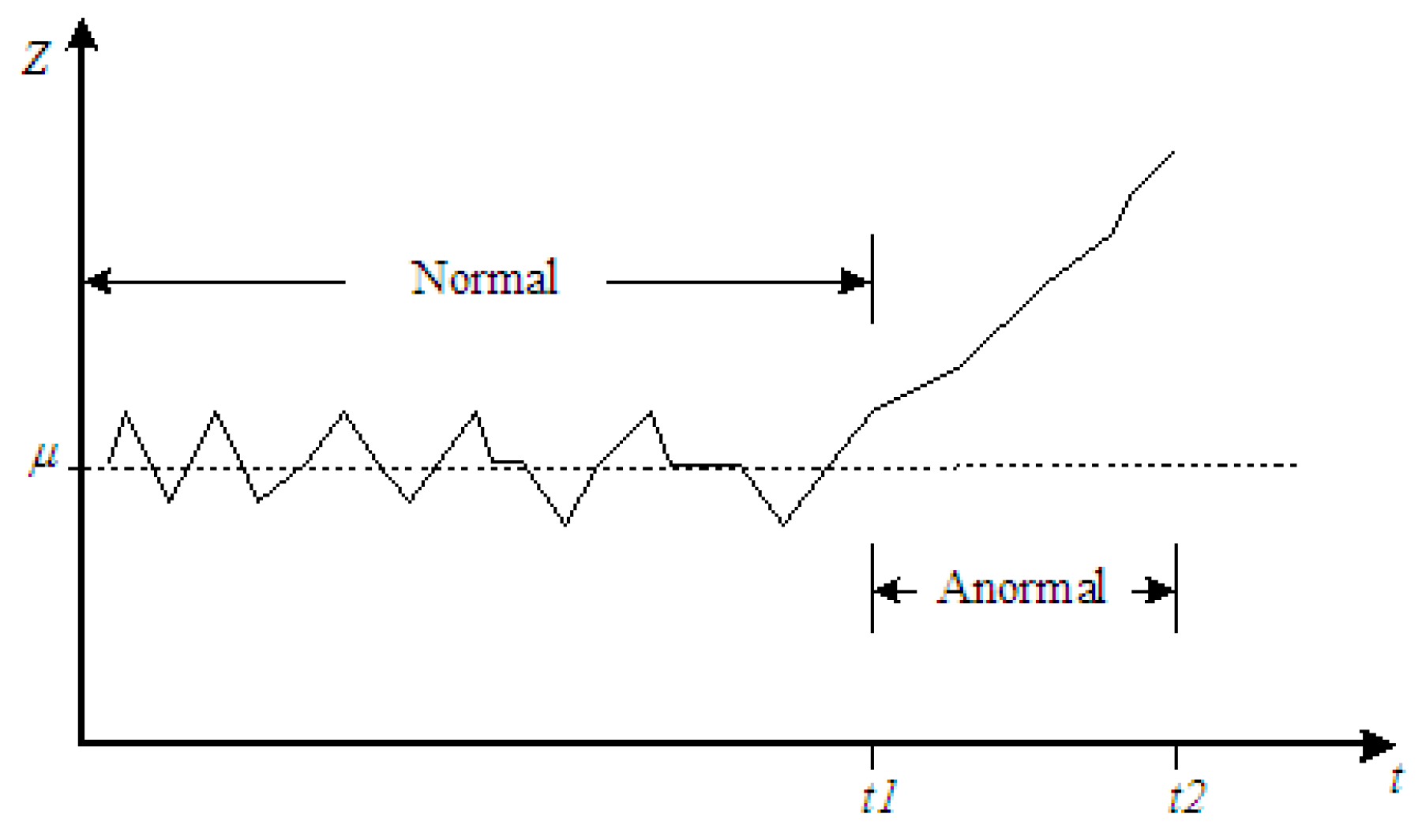
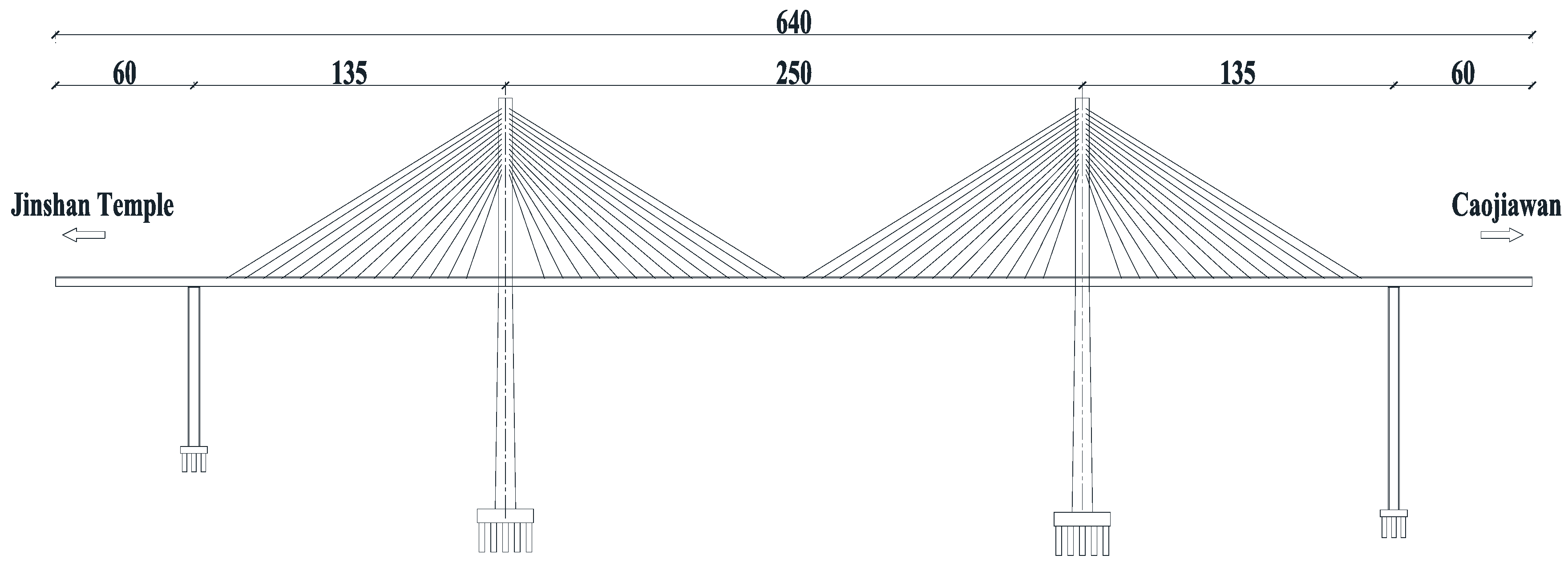

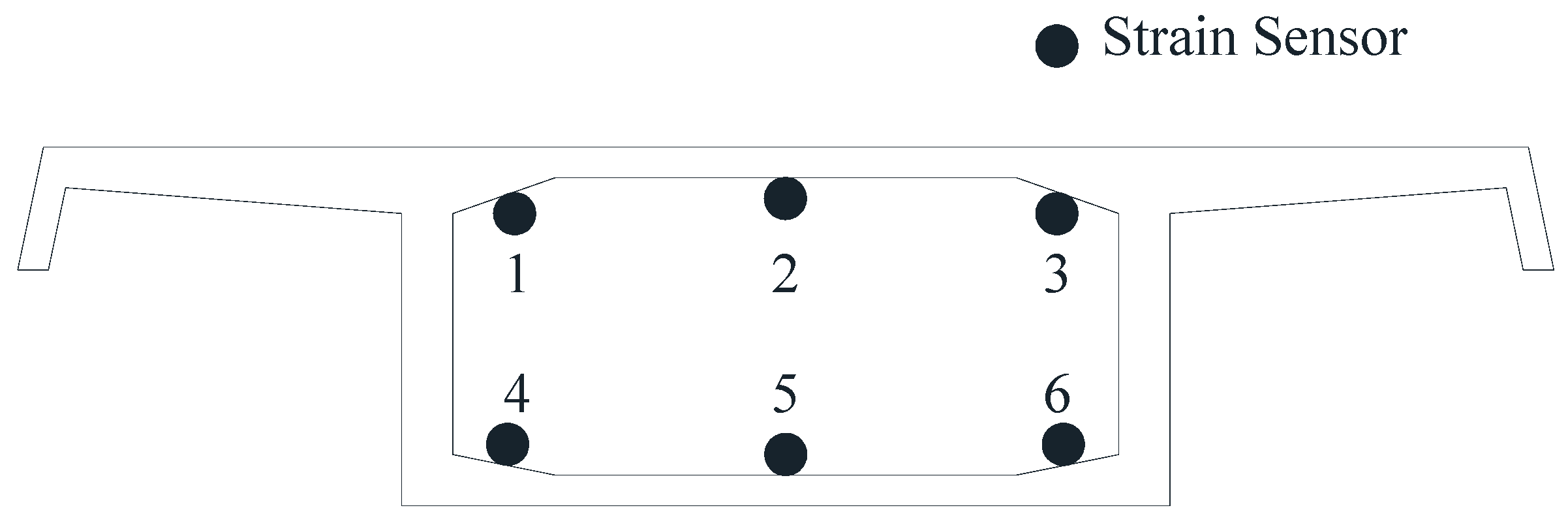

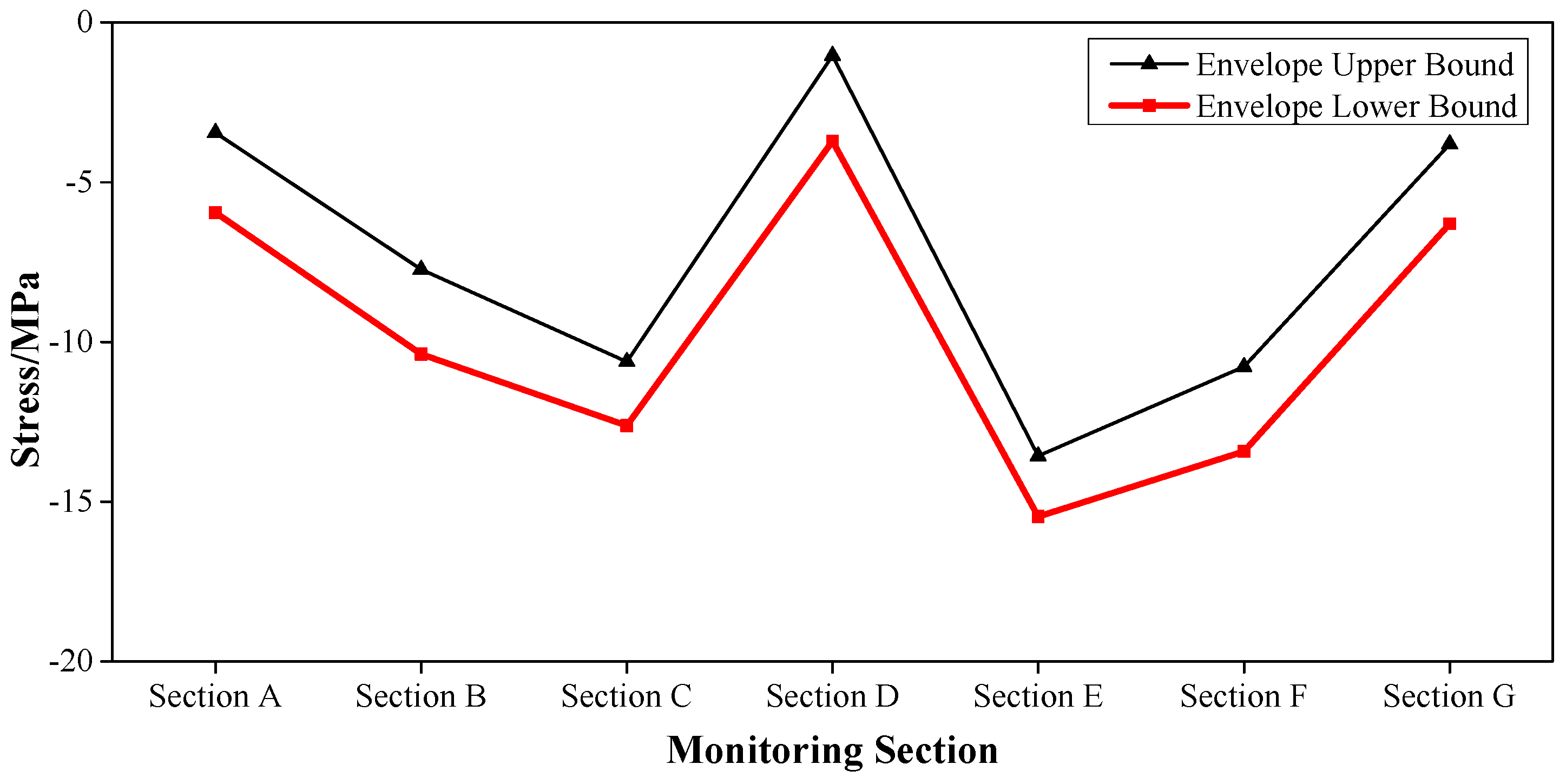
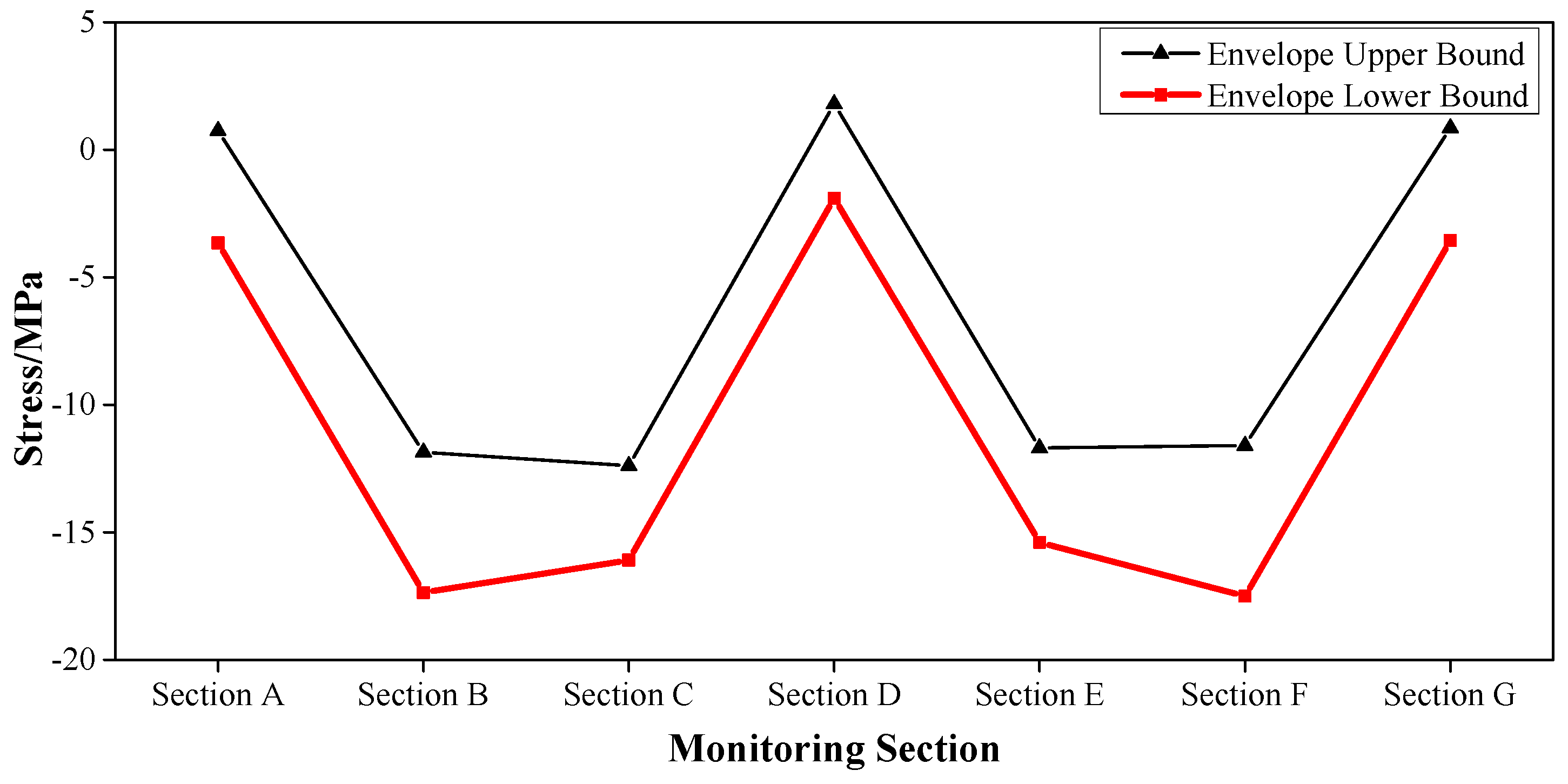
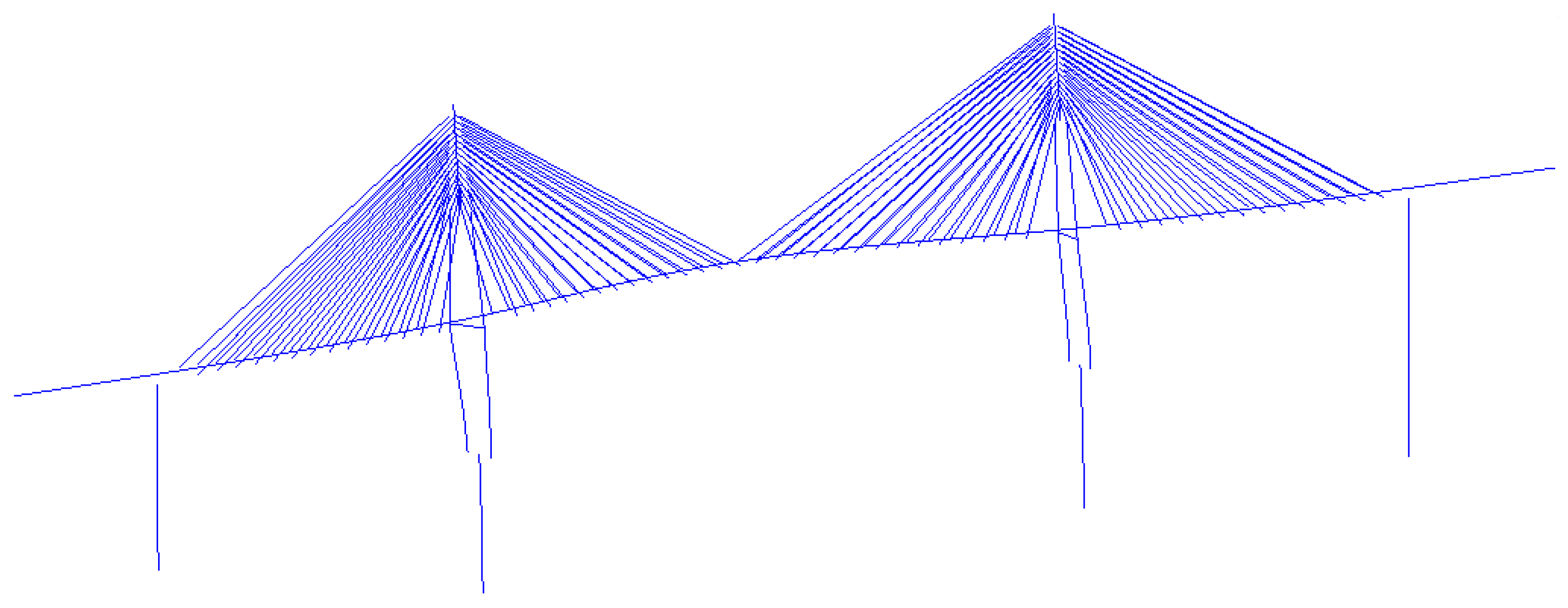







| Bridge Type | Girder Bridge | Arch Bridge | Cable-Stayed Bridge | Suspension Bridge | ||
|---|---|---|---|---|---|---|
| Categories | ||||||
| load and environment | moving load | ★ | ★ | ★ | ★ | |
| earthquake | ★ | ★ | ★ | ★ | ||
| impact | ★ | ★ | ★ | ★ | ||
| temperature | ▲ | ▲ | ▲ | ▲ | ||
| humidity | ▲ | ▲ | ▲ | ▲ | ||
| wind speed and direction | ◇ | ★ | ▲ | ▲ | ||
| rainfall | ★ | ★ | ★ | ★ | ||
| the overall response of the structure | vibration | ▲ | ▲ | ▲ | ▲ | |
| deformation | ▲ | ▲ | ▲ | ▲ | ||
| rotation angle | ◇ | ◇ | ★ | ★ | ||
| the local response of the structure | stress | ▲ | ▲ | ▲ | ▲ | |
| cable force | ○ | ▲ | ▲ | ▲ | ||
| crack | ★ | ★ | ★ | ★ | ||
| fatigue | ○ | ★ | ★ | ★ | ||
| corrosion | ★ | ★ | ★ | ★ | ||
| changing and the reaction of supports | ★ | ★ | ★ | ★ | ||
| foundation erosion | ★ | ★ | ★ | ★ | ||
| Load | DZ | rDZ | |
|---|---|---|---|
| train live load | min | −154 | −115 |
| max | 31 | 23 | |
| transverse rocking force | + | 0 | 0 |
| − | 0 | 0 | |
| braking force | + | 0 | 0 |
| − | 0 | 0 | |
| temperature load [38] | system temperature rising | 21 | 16 |
| system temperature dropping | −21 | −16 | |
| component temperature rising | −41 | −31 | |
| component temperature dropping | 41 | 31 | |
| gradient temperature rising | 10 | 7 | |
| gradient temperature dropping | −5 | −4 | |
| wind load | transverse wind + | 0 | 0 |
| transverse wind − | 0 | 0 | |
| longitudinal wind + | 0 | 0 | |
| longitudinal wind − | 0 | 0 | |
| train wind + | 0 | 0 | |
| train wind − | 0 | 0 | |
| water pressure | + | 0 | 0 |
| − | 0 | 0 | |
| Order | Calculated Frequency (Hz) | Period (s) | Description of Vibration Mode |
|---|---|---|---|
| 1 | 0.686 | 1.457 | Transverse Vibration of Bridge Tower + Transverse Bending of Beam |
| 2 | 0.752 | 1.330 | Anti-symmetric Transverse Vibration of Bridge Tower + Transverse Bending of Beam |
| 3 | 0.8702 | 1.149 | Longitudinal Drift of the Beam |
| 4 | 0.8852 | 1.130 | First-order Symmetric Vertical Bending |
| 5 | 1.1352 | 0.881 | First-order Symmetric Transverse Bending |
© 2017 by the authors. Licensee MDPI, Basel, Switzerland. This article is an open access article distributed under the terms and conditions of the Creative Commons Attribution (CC BY) license ( http://creativecommons.org/licenses/by/4.0/).
Share and Cite
Zhou, J.; Li, X.; Xia, R.; Yang, J.; Zhang, H. Health Monitoring and Evaluation of Long-Span Bridges Based on Sensing and Data Analysis: A Survey. Sensors 2017, 17, 603. https://doi.org/10.3390/s17030603
Zhou J, Li X, Xia R, Yang J, Zhang H. Health Monitoring and Evaluation of Long-Span Bridges Based on Sensing and Data Analysis: A Survey. Sensors. 2017; 17(3):603. https://doi.org/10.3390/s17030603
Chicago/Turabian StyleZhou, Jianting, Xiaogang Li, Runchuan Xia, Jun Yang, and Hong Zhang. 2017. "Health Monitoring and Evaluation of Long-Span Bridges Based on Sensing and Data Analysis: A Survey" Sensors 17, no. 3: 603. https://doi.org/10.3390/s17030603
APA StyleZhou, J., Li, X., Xia, R., Yang, J., & Zhang, H. (2017). Health Monitoring and Evaluation of Long-Span Bridges Based on Sensing and Data Analysis: A Survey. Sensors, 17(3), 603. https://doi.org/10.3390/s17030603







